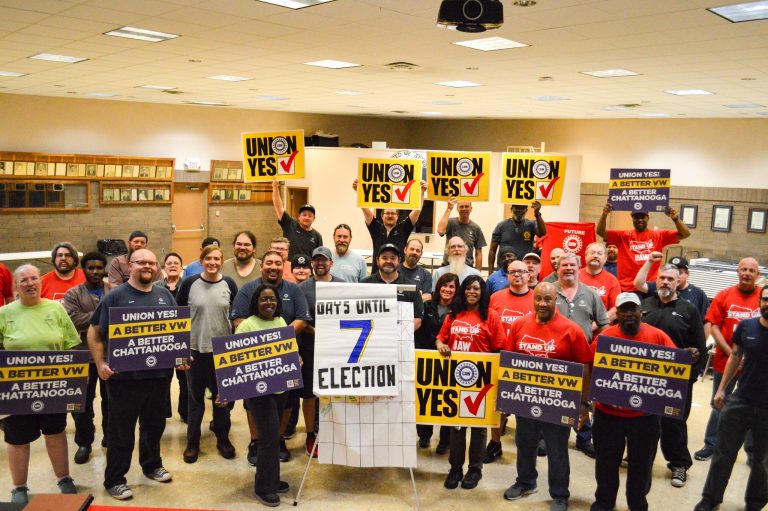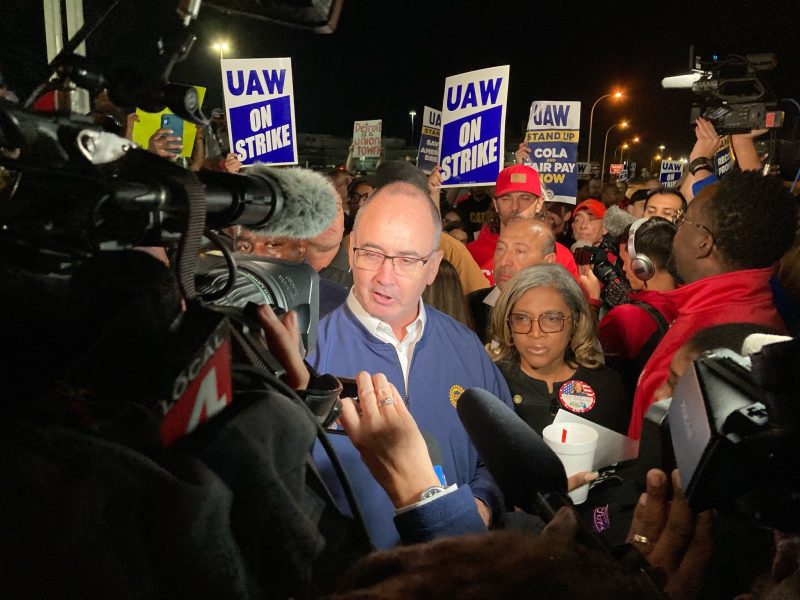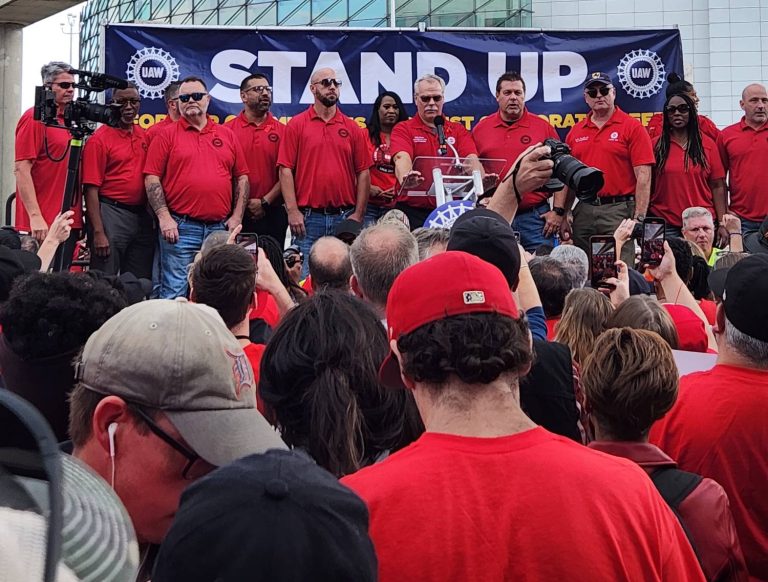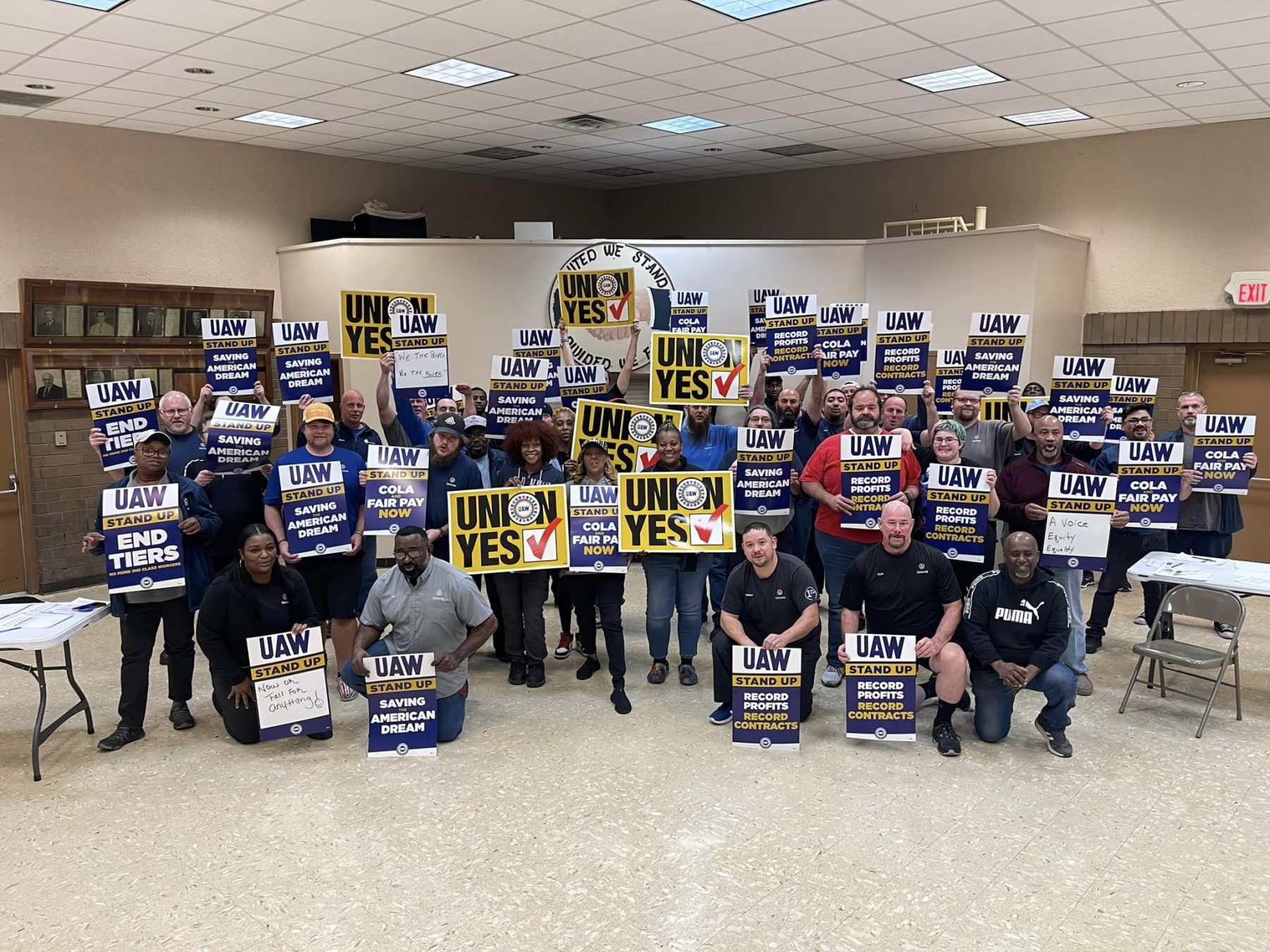Last week, workers at a Volkswagen plant in Chattanooga, Tennessee voted to join the United Auto Workers (UAW). The overwhelming result—2,628 to 985—is the UAW’s first success at a foreign-owned automaker in the South. UAW President Shawn Fain called it “the first domino to fall” in the union’s campaign to organize 13 companies including Tesla, BMW, Toyota, Nissan, Honda, and Hyundai. The next target is a Mercedes-Benz plant in Vance, Alabama where 5,200 workers will vote May 13–17.
[Originally published at socialistrevolution.org]
From the 1950s to the early 1970s, US autoworkers were nearly 100% organized. The “Big Three”—GM, Ford, and Chrysler (now Stellantis)—dominated US car and truck production. Even many parts suppliers were unionized, usually subsidiaries of the Big Three, like GM’s ACDelco and Ford’s Motorcraft. Today only about 16% of the industry is unionized.
UAW was 1.5 million strong in the late 1970s but now has fewer than 400,000 active members, including 150,000 at GM, Ford, and Stellantis. Technological innovations, outsourcing to nonunion suppliers, and assembly line speedups all conspired to reduce membership. Prior to last week, the UAW had not organized any auto plants built in the last four decades by companies like Toyota, Volkswagen, Mercedes, and others.
Sit-down or stand-up?
 Volkswagen workers in Chattanooga voted to join the UAW. It’s the union’s first success organizing a foreign-owned automaker in the South / Image: UAW Volkswagen Local 42, Facebook
Volkswagen workers in Chattanooga voted to join the UAW. It’s the union’s first success organizing a foreign-owned automaker in the South / Image: UAW Volkswagen Local 42, Facebook
In the fall of 2023, Fain led a “stand-up strike” against the Big Three. We explained that although last year’s contracts were better than prior settlements, workers could have achieved much more if the union had mobilized a massive fightback appealing to the broader labor movement and unorganized workers.
Ultimately, 68% voted to ratify the contracts at Ford and Stellantis, while 54% voted yes at GM. Workers did win an immediate 11% raise and a $5,000 bonus. Despite its limitations, the partial victory had a major impact at unorganized auto factories. Honda, Hyundai, and Toyota announced immediate raises, fearing workers might now be attracted to the UAW.
Fain is using these recent advances to help organize 150,000 workers at 13 unorganized auto companies. He’s pursuing a plant-by-plant strategy called the “30-50-70” plan. Once 30% of the employees at a plant sign UAW cards, there is a public announcement that an organizing committee has formed. When 50% of the plant signs up, Fain attends a UAW rally there. Once they get 70% to sign, they ask the bosses for recognition. If they don’t get it, they file for a National Labor Relations Board (NLRB) election.
Communists will help this organizing drive in any way possible. Unions—workers organized to fight together—are the first line of defense against the bosses, and revolutionary communists work to build militant unions. But victory on this scale will require more than riding the recent wave of labor militancy.
A winning strategy must flow from a clear political understanding of lessons learned in past class battles. We know there are serious limitations to relying on the NLRB (an arm of the capitalist state) rather than on workers’ power to stop production.
In the 1930s, the UAW organized workers through class struggle. Victories against the bosses came from shutting down production, not “partnership” with the class enemy. UAW militants occupied factories in the famous “sit-down strikes.” A plant occupied by striking workers cannot produce cars with scab labor.
The Flint sit-down strike of 1936–37 was not a plant-by-plant effort. Flint’s workers demanded the bosses recognize the UAW as the representative of all GM workers who joined the union regardless of where they worked. They called for one standard of wages, benefits, and working conditions for all UAW members. Thanks to this bold strategy, sit-down strikes spread across the Midwest, and GM workers achieved one of the greatest victories in American labor history.
Fain’s initiatives
 New militancy from below caused splits at the top of some unions, including in the UAW where Fain broke with the old leadership and joined the UAWD reform caucus / Image: UAW, Facebook
New militancy from below caused splits at the top of some unions, including in the UAW where Fain broke with the old leadership and joined the UAWD reform caucus / Image: UAW, Facebook
Prior to Fain’s presidency, UAW leaders tried to organize nonunion plants by acting as “partners” to the bosses. This didn’t convince workers, and the union suffered defeats at Volkswagen and Mercedes. Fain’s election reflected the working-class anger that has been building for decades. No union leader has put forward a strategy to successfully fight a half century of savage attacks on wages, benefits, and working conditions. This led to radicalization, particularly among young workers. Industries with higher concentrations of young people have seen many organizing drives in recent years, including at Starbucks, Amazon, REI, and others.
New militancy from below caused splits at the top of some unions, as a wing of the old leadership sought to channel rank-and-file energy and anger. In the Teamsters, Sean O’Brien split from Hoffa, allying with Teamsters for a Democratic Union and winning control. In the UAW, Fain broke with the old leadership and joined the Unite All Workers for Democracy reform caucus.
Now Fain is relying on the momentum from recent battles to organize unorganized autoworkers, but his strategy remains within the stifling limits of US labor law. These convoluted rules are designed to prevent workers from building a real fighting union. Adherence to the class enemy’s rules is largely responsible for the decline in union membership. In 1983, more than a fifth of American workers were organized. Now only 11% are.
To get the most out of this organizing drive, Fain should look to UAW history. Labor law dictates that unions can only be organized from workplace to workplace. If it wants to win, the UAW should disregard this. Just like in the 1930s, the goal must be for all workers in all plants of all auto companies to be organized and covered by contracts matching or exceeding the best terms of already established deals. In other words: 100% union!
When enough workers join the campaign, they should demand recognition. Regardless of whether an NLRB election is set, workers can win recognition, improved wages, and better conditions by using their power to withhold their labor and shut down production. Fain should not rely on NLRB rules or rulings which are always designed to stall and defeat organizing campaigns.
 Instead of all-out action, the “stand-up strike” used the mere threat of a broader action to force concessions from the auto barons / Image: UAW, Facebook
Instead of all-out action, the “stand-up strike” used the mere threat of a broader action to force concessions from the auto barons / Image: UAW, Facebook
Fain appealed to the memory of the sit-down strikes during the 2023 “stand-up strike.” This spoke to militants ready for a real fight. But the stand-up strike also held workers back. The whole idea was to limit the number of striking workers. Fain’s team directed some plants to “stand up” and strike, while workers at other factories continued producing. Instead of all-out action, he used the mere threat of a broader action to force concessions from the auto barons. But newer workers are still excluded from the company pensions, and the raises didn’t make up for losses to inflation since 2009.
Join the RCA and help build militant unions!
While the Fain leadership reflects the growing class anger, it has not put forward independent class politics. During the recent strike, Democratic President Joe Biden went to one of the picket lines. Fain should have told Biden to get lost! Instead, he allowed the American capitalists’ top representative to engage in phony, pro-worker posing. Since then, the union has come out for a ceasefire in Gaza—in opposition to both Biden and Donald Trump. But this was greatly undermined in January when Fain endorsed Biden’s reelection campaign. In a disgusting turn, the union’s security team was even used against UAW members protesting Biden’s backing of Israel.
Fain has managed some limited victories and helped open a path for unorganized autoworkers to join UAW. But he has also taken half steps where bold leaps are necessary. He refuses to break with the Democrats and escape the straitjacket of capitalist labor law. We can be confident that the workers will learn much in present and future struggles.
Revolutionary communists are the most advanced layer of the working class. We see Fain’s steps forward and his moves in the wrong direction. Ultimately, the working class needs communist leadership to achieve its historic goals. To build this leadership, communists will support all positive initiatives from leaders like Fain, while pointing to their limitations and reminding workers of their militant traditions. Communists will help organize the unorganized and transform today’s unions into fighting organizations. Through the class struggle, we can build our present forces into a mass force. With a mass revolutionary party, there will be nothing that can stop the working class from overthrowing the decaying capitalist system and replacing it with a truly humane system.

